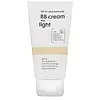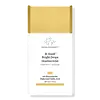What's inside
What's inside
 Key Ingredients
Key Ingredients

 Benefits
Benefits

 Concerns
Concerns

 Ingredients Side-by-side
Ingredients Side-by-side

Water
Skin ConditioningCI 77891
Cosmetic ColorantEthylhexyl Salicylate
UV AbsorberGlycerin
HumectantNiacinamide
SmoothingDibutyl Adipate
EmollientButyl Methoxydibenzoylmethane
UV AbsorberDistarch Phosphate
AbsorbentIsopropyl Isostearate
EmollientPotassium Cetyl Phosphate
EmulsifyingC12-15 Alkyl Benzoate
AntimicrobialCetearyl Alcohol
EmollientTitanium Dioxide
Cosmetic ColorantCaprylic/Capric Triglyceride
MaskingSaccharide Isomerate
HumectantVp/Hexadecene Copolymer
Diethylhexyl Butamido Triazone
UV AbsorberHydroxyacetophenone
AntioxidantEthylhexyl Triazone
UV Absorber1,2-Hexanediol
Skin ConditioningPhenoxyethanol
PreservativeCI 77492
Cosmetic ColorantSilica
AbrasiveXanthan Gum
EmulsifyingCI 77491
Cosmetic ColorantParfum
MaskingPolyhydroxystearic Acid
EmulsifyingMagnesium Aluminum Silicate
AbsorbentCI 77499
Cosmetic ColorantAlumina
AbrasiveStearic Acid
CleansingSodium Hydroxide
BufferingTetrasodium Glutamate Diacetate
Sodium Citrate
BufferingCitric Acid
BufferingWater, CI 77891, Ethylhexyl Salicylate, Glycerin, Niacinamide, Dibutyl Adipate, Butyl Methoxydibenzoylmethane, Distarch Phosphate, Isopropyl Isostearate, Potassium Cetyl Phosphate, C12-15 Alkyl Benzoate, Cetearyl Alcohol, Titanium Dioxide, Caprylic/Capric Triglyceride, Saccharide Isomerate, Vp/Hexadecene Copolymer, Diethylhexyl Butamido Triazone, Hydroxyacetophenone, Ethylhexyl Triazone, 1,2-Hexanediol, Phenoxyethanol, CI 77492, Silica, Xanthan Gum, CI 77491, Parfum, Polyhydroxystearic Acid, Magnesium Aluminum Silicate, CI 77499, Alumina, Stearic Acid, Sodium Hydroxide, Tetrasodium Glutamate Diacetate, Sodium Citrate, Citric Acid
Water
Skin ConditioningGlycerin
HumectantButylene Glycol
HumectantNiacinamide
SmoothingPropanediol
SolventNeopentyl Glycol Diheptanoate
EmollientMica
Cosmetic ColorantEthylhexyl Olivate
Skin ConditioningC9-12 Alkane
SolventCoco-Caprylate/Caprate
EmollientSclerocarya Birrea Seed Oil
HumectantCetearyl Alcohol
EmollientSimmondsia Chinensis Seed Oil
EmollientDiglucosyl Gallic Acid
Squalane
EmollientSorbitan Sesquiisostearate
EmulsifyingPlukenetia Volubilis Seed Oil
EmollientMorus Alba Leaf Extract
Skin ConditioningCalcium Chloride
AstringentSea Salt
AbrasiveSodium Stearate
CleansingHydroxyethyl Acrylate/Sodium Acryloyldimethyl Taurate Copolymer
Emulsion StabilisingTocopheryl Acetate
AntioxidantQuercetin
AntioxidantPPG-8-Ceteth-20
EmulsifyingSodium Carrageenan
Emulsion StabilisingGlyceryl Acrylate/Acrylic Acid Copolymer
HumectantXanthan Gum
EmulsifyingPhenoxyethanol
PreservativeSodium Metabisulfite
AntioxidantUbiquinone
AntioxidantAcrylates/Beheneth-25 Methacrylate Copolymer
C12-15 Alkyl Benzoate
AntimicrobialCitric Acid
BufferingTetrasodium Glutamate Diacetate
Sodium Citrate
BufferingCeteareth-20
CleansingDipropylene Glycol
HumectantTocopherol
AntioxidantSorbitan Isostearate
EmulsifyingPolysorbate 60
EmulsifyingSodium Hydroxide
BufferingSorbeth-30 Tetraisostearate
EmulsifyingCI 77491
Cosmetic ColorantCI 77492
Cosmetic ColorantCI 77891
Cosmetic ColorantWater, Glycerin, Butylene Glycol, Niacinamide, Propanediol, Neopentyl Glycol Diheptanoate, Mica, Ethylhexyl Olivate, C9-12 Alkane, Coco-Caprylate/Caprate, Sclerocarya Birrea Seed Oil, Cetearyl Alcohol, Simmondsia Chinensis Seed Oil, Diglucosyl Gallic Acid, Squalane, Sorbitan Sesquiisostearate, Plukenetia Volubilis Seed Oil, Morus Alba Leaf Extract, Calcium Chloride, Sea Salt, Sodium Stearate, Hydroxyethyl Acrylate/Sodium Acryloyldimethyl Taurate Copolymer, Tocopheryl Acetate, Quercetin, PPG-8-Ceteth-20, Sodium Carrageenan, Glyceryl Acrylate/Acrylic Acid Copolymer, Xanthan Gum, Phenoxyethanol, Sodium Metabisulfite, Ubiquinone, Acrylates/Beheneth-25 Methacrylate Copolymer, C12-15 Alkyl Benzoate, Citric Acid, Tetrasodium Glutamate Diacetate, Sodium Citrate, Ceteareth-20, Dipropylene Glycol, Tocopherol, Sorbitan Isostearate, Polysorbate 60, Sodium Hydroxide, Sorbeth-30 Tetraisostearate, CI 77491, CI 77492, CI 77891
Ingredients Explained
These ingredients are found in both products.
Ingredients higher up in an ingredient list are typically present in a larger amount.
C12-15 Alkyl Benzoate is made up of Benzoic Acid and long chain alcohols. It has a low molecular weight.
C12-15 Alkyl Benzoate is an emollient and texture enhancer. Due to its solubility, it is often used in sunscreens to help evenly distribute active ingredients.
As an emollient, C12-15 Alkyl Benzoate helps soften and hydrate your skin. Emollients create a film on your skin that traps moisture within.
This ingredient has been reported to cause eye irritation.
Learn more about C12-15 Alkyl BenzoateCetearyl alcohol is a mixture of two fatty alcohols: cetyl alcohol and stearyl alcohol. It is mainly used as an emulsifier. Emulsifiers help prevent the separation of oils and products. Due to its composition, it can also be used to thicken a product or help create foam.
Cetearyl alcohol is an emollient. Emollients help soothe and hydrate the skin by trapping moisture.
Studies show Cetearyl alcohol is non-toxic and non-irritating. The FDA allows products labeled "alcohol-free" to have fatty alcohols.
This ingredient is usually derived from plant oils such as palm, vegetable, or coconut oils. There is debate on whether this ingredient will cause acne.
Due to the fatty acid base, this ingredient may not be Malassezia folliculitis safe.
Learn more about Cetearyl AlcoholCi 77491 is also hydrated iron III oxide. It's sole purpose is to give a red/pink hue to products.
Iron III oxides are classified as inorganic chemicals for coloring.
Synthetically created Ci 77491 is considered safer than those naturally found. This is because the synthetically created version may contain less impurities. Iron oxides are generally non-toxic and non-allergenic.
Learn more about CI 77491Ci 77492 is also hydrated iron III oxide. It's sole purpose is to give a yellow hue to products.
Iron III oxides are classified as inorganic chemicals for coloring.
Synthetically created Ci 77492 is considered safer than those naturally found. This is because the synthetically created version may contain less impurities. Iron oxides are generally non-toxic and non-allergenic.
Learn more about CI 77492Ci 77891 is a white pigment from Titanium dioxide. It is naturally found in minerals such as rutile and ilmenite.
It's main function is to add a white color to cosmetics. It can also be mixed with other colors to create different shades.
Ci 77891 is commonly found in sunscreens due to its ability to block UV rays.
Learn more about CI 77891Citric Acid is an alpha hydroxy acid (AHA) naturally found in citrus fruits like oranges, lemons, and limes.
Like other AHAs, citric acid can exfoliate skin by breaking down the bonds that hold dead skin cells together. This helps reveal smoother and brighter skin underneath.
However, this exfoliating effect only happens at high concentrations (20%) which can be hard to find in cosmetic products.
Due to this, citric acid is usually included in small amounts as a pH adjuster. This helps keep products slightly more acidic and compatible with skin's natural pH.
In skincare formulas, citric acid can:
While it can provide some skin benefits, research shows lactic acid and glycolic acid are generally more effective and less irritating exfoliants.
Most citric acid used in skincare today is made by fermenting sugars (usually from molasses). This synthetic version is identical to the natural citrus form but easier to stabilize and use in formulations.
Read more about some other popular AHA's here:
Learn more about Citric AcidGlycerin is already naturally found in your skin. It helps moisturize and protect your skin.
A study from 2016 found glycerin to be more effective as a humectant than AHAs and hyaluronic acid.
As a humectant, it helps the skin stay hydrated by pulling moisture to your skin. The low molecular weight of glycerin allows it to pull moisture into the deeper layers of your skin.
Hydrated skin improves your skin barrier; Your skin barrier helps protect against irritants and bacteria.
Glycerin has also been found to have antimicrobial and antiviral properties. Due to these properties, glycerin is often used in wound and burn treatments.
In cosmetics, glycerin is usually derived from plants such as soybean or palm. However, it can also be sourced from animals, such as tallow or animal fat.
This ingredient is organic, colorless, odorless, and non-toxic.
Glycerin is the name for this ingredient in American English. British English uses Glycerol/Glycerine.
Learn more about GlycerinNiacinamide is a multitasking form of vitamin B3 that strengthens the skin barrier, reduces pores and dark spots, regulates oil, and improves signs of aging.
And the best part? It's gentle and well-tolerated by most skin types, including sensitive and reactive skin.
You might have heard of "niacin flush", or the reddening of skin that causes itchiness. Niacinamide has not been found to cause this.
In very rare cases, some individuals may not be able to tolerate niacinamide at all or experience an allergic reaction to it.
If you are experiencing flaking, irritation, and dryness with this ingredient, be sure to double check all your products as this ingredient can be found in all categories of skincare.
When incorporating niacinamide into your routine, look out for concentration amounts. Typically, 5% niacinamide provides benefits such as fading dark spots. However, if you have sensitive skin, it is better to begin with a smaller concentration.
When you apply niacinamide to your skin, your body converts it into nicotinamide adenine dinucleotide (NAD). NAD is an essential coenzyme that is already found in your cells as "fuel" and powers countless biological processes.
In your skin, NAD helps repair cell damage, produce new healthy cells, support collagen production, strengthen the skin barrier, and fight environmental stressors (like UV and pollution).
Our natural NAD levels start to decline with age, leading to slower skin repair, visible aging, and a weaker skin barrier. By providing your skin niacinamide, you're recharging your skin's NAD levels. This leads to stronger, healthier, and younger looking skin.
Another name for vitamin B3 is nicotinamide. This vitamin is water-soluble and our bodies don't store it. We obtain Vitamin B3 from either food or skincare. Meat, fish, wheat, yeast, and leafy greens contain vitamin B3.
The type of niacinamide used in skincare is synthetically created.
Learn more about NiacinamidePhenoxyethanol is a preservative that has germicide, antimicrobial, and aromatic properties. Studies show that phenoxyethanol can prevent microbial growth. By itself, it has a scent that is similar to that of a rose.
It's often used in formulations along with Caprylyl Glycol to preserve the shelf life of products.
Sodium Citrate is the sodium salts of citric acid. In skincare, it is used to alter pH levels and acts as a preservative.
Its main functions are to maintain the pH of a product and neutralize metal ions.
The acidity of our skin is maintained by our glands and skin biome; normal pH level of skin is slightly acidic (~4.75-5.5).
Being slightly acidic allows our skin to create an "acid mantle". This acid mantle is a thin barrier that protects our skin from bacteria and contaminants.
Learn more about Sodium CitrateSodium Hydroxide is also known as lye or caustic soda. It is used to adjust the pH of products; many ingredients require a specific pH to be effective.
In small amounts, sodium hydroxide is considered safe to use. However, large amounts may cause chemical burns due to its high alkaline.
Your skin has a natural pH and acid mantle. This acid mantle helps prevent harmful bacteria from breaking through. The acid mantle also helps keep your skin hydrated.
"Alkaline" refers to a high pH level. A low pH level would be considered acidic.
Learn more about Sodium HydroxideTetrasodium Glutamate Diacetate is a chelating agent. Chelating agents help prevent metal ions from binding to other ingredients. This helps prevent unwanted effects and reactions from a product. These metal ions may come from water and are found in miniscule amounts.
Tetrasodium Glutamate Diacetate can also help other preservatives be more effective.
Water. It's the most common cosmetic ingredient of all. You'll usually see it at the top of ingredient lists, meaning that it makes up the largest part of the product.
So why is it so popular? Water most often acts as a solvent - this means that it helps dissolve other ingredients into the formulation.
You'll also recognize water as that liquid we all need to stay alive. If you see this, drink a glass of water. Stay hydrated!
Learn more about WaterXanthan gum is used as a stabilizer and thickener within cosmetic products. It helps give products a sticky, thick feeling - preventing them from being too runny.
On the technical side of things, xanthan gum is a polysaccharide - a combination consisting of multiple sugar molecules bonded together.
Xanthan gum is a pretty common and great ingredient. It is a natural, non-toxic, non-irritating ingredient that is also commonly used in food products.
Learn more about Xanthan Gum